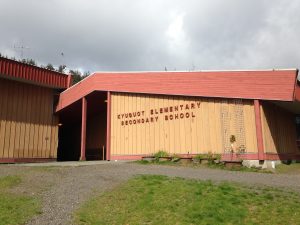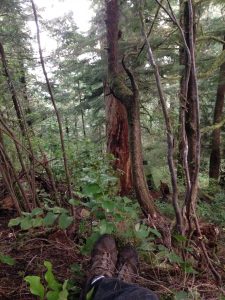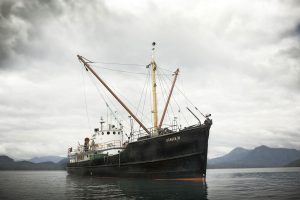To live is to experience.
To experience is to learn.
To learn is to grow.
I have learned much over the past year about ways I can expand my teacher tool kit, but my most recent experience in Kyuquot has shown me an “inner” tool kit – the ways in which I personally relate to new ideas and environments, not grounded in theory but lived experience. My CFE has also challenged me to re-evaluate how and when I can apply my own teacher’s tool kit to new learning contexts – it is not simply a matter of how my students relate to me, but also how I relate to my students. The nature of an awesome learning experience is not necessarily found in a well-planned lesson or structure of a school. The nature of an awesome learning experience is found in relationship building. Relationship is everything. A teacher’s ability to forge healthy relationships with students will determine the ways in which they can assist students to reach personal academic success. But relationships are never easy and at the core of any healthy relationship is trust. My personal interactions with the students of K.E.S.S. these past few weeks have enabled me to build the foundation of a relationship based on trust, though I feel more time would be needed for trust to grow and the relationship to flourish so that respectful learning environments can be supported. Regarding student misbehaviour, the new approach at the school has been to surround misbehaving students with adult members of the school community. By promoting healthy relationships based on mutual trust, as opposed to an obedience to authority, learning professionals can build bridges to colleagues, disciplines, students, parents, administrators, and the larger community. Most First Nations across our country survived the culture of colonialism in the past, but this culture has not gone away and the reverberations of this generational injustice is still felt in communities and classrooms. One key question then remains: How are we, as learning professionals, to establish relationships based on trust with our students? Over the past weeks, I have been thinking about this question and would like to explore two alternatives: Social and Emotional Learning and Restorative Justice.
 Social and Emotional Learning (SEL) is an approach to teaching that allows students to integrate their skills, attitudes, and behaviours to deal ethically with tasks and challenges. It promotes intrapersonal, interpersonal, and cognitive competence. Now, there are five pillars to SEL: Self-Awareness, self-management, social awareness, relationship skills, and responsible decision-making. Many of the students at K.E.S.S. struggle daily with self-efficacy, self-regulation, perspective-taking, reflecting, and communicating – all of which are essential 21st century skills and values. It seems reasonable to me that a multi-grade classroom with students of various abilities would require an alternative approach to instruction, or a move away from a traditional, industrial-era mindset. Most exciting for me, is SEL’s capacity to engage whole communities, motivating parents from interest in their child’s education and towards participation.
Social and Emotional Learning (SEL) is an approach to teaching that allows students to integrate their skills, attitudes, and behaviours to deal ethically with tasks and challenges. It promotes intrapersonal, interpersonal, and cognitive competence. Now, there are five pillars to SEL: Self-Awareness, self-management, social awareness, relationship skills, and responsible decision-making. Many of the students at K.E.S.S. struggle daily with self-efficacy, self-regulation, perspective-taking, reflecting, and communicating – all of which are essential 21st century skills and values. It seems reasonable to me that a multi-grade classroom with students of various abilities would require an alternative approach to instruction, or a move away from a traditional, industrial-era mindset. Most exciting for me, is SEL’s capacity to engage whole communities, motivating parents from interest in their child’s education and towards participation.
Restorative Justice distinguishes itself from traditional criminal justice by adopting an alternative approach to conflict resolution. This alternative approach in based on providing individuals in conflict the opportunity to voice their concerns and decide together what should be done to repair the harm. In an educational setting, misbehaviour hurts, but the act and process of coming together, voicing concerns, and collectively deciding what must be done to make amends, will heal. It emphasizes understanding why relationships work, as opposed to how relationships work. Restorative justice, then, represents a validation of values. In an alternative education setting, particularly the setting around K.E.S.S., I truly feel that disciplinary practices rooted in restorative justice would allow for relationships based on trust to flourish.
Being in a remote community of a rural school district has also taught me to challenge my  views on the pedagogical implications of promoting the classroom as a space for learning. Out here, there is learning in the soil, trees, rocks, and water – an untapped, renewable wellspring of knowledge. For example, junior and senior students had the excellent opportunity to go whitewater rafting on the Nimpkish River. When they returned from the excursion, they were clearly invigorated by the experience, but I felt as though a learning opportunity might have been lost in not following the activity up with a reflective exercise on what they learned, though I know that it will remain an experience they share and cherish. To me, it is not only a question of whether or not I know what they learned, but also whether or not they know what they learned.
views on the pedagogical implications of promoting the classroom as a space for learning. Out here, there is learning in the soil, trees, rocks, and water – an untapped, renewable wellspring of knowledge. For example, junior and senior students had the excellent opportunity to go whitewater rafting on the Nimpkish River. When they returned from the excursion, they were clearly invigorated by the experience, but I felt as though a learning opportunity might have been lost in not following the activity up with a reflective exercise on what they learned, though I know that it will remain an experience they share and cherish. To me, it is not only a question of whether or not I know what they learned, but also whether or not they know what they learned.
My time in Kyuquot taught me about spontaneity. This bit of wisdom is often passed on from generation to generation, but to truly thrive in a rural district on the west coast of Vancouver Island, this spirit must be embodied. Islanders often joke about how Vancouverites complain about the mildest shift in weather. As a North Islander myself, I thought that I understood unpredictable weather, but Kyuquot taught me that spontaneity is a key ingredient of flourishing in this isolated corner of the world. It is often wet and cold for most of the year, so when the sun shines and opportunity knocks, one must be prepared to go on an impromptu fishing trip, kayaking adventure, or wilderness trek. My personality thrives on structure and predictability and this made fitting in with the local community a challenging and rewarding experience. It also allowed me to push my comfort levels and re-evaluate how I define adaptability. Spontaneity, as we know, is also important in pedagogy, as educators work hard every day to ignite the spark of creativity and imagination in students of all ages. So, once again, the physical environment of Kyuquot taught me how to be a better reflective practitioner.
 In true Islander fashion, I received a maritime send-off aboard the MV Uchuck III bound for Gold River. The Uchuck is a freight boat that doubles as a passenger boat for tourists and kayak enthusiasts. Boarding time was 5:30 in the morning and my colleagues ferried me across the bay to Walter’s Island where the boat was docked. The slow journey provided me with a unique opportunity to reflect on the history and appreciate the beauty of Vancouver Island’s west coast. I am immensely appreciative of my time in Kyuquot for the relationships I have made, experiences I have had, and the lessons I have learned. No matter where teaching takes me, the islets, forests, and mountains of Kyuquot Sound will remind me of the diverse experiences I have shared with the people of this place, as well as the primacy of relationship building in a quality 21st century education.
In true Islander fashion, I received a maritime send-off aboard the MV Uchuck III bound for Gold River. The Uchuck is a freight boat that doubles as a passenger boat for tourists and kayak enthusiasts. Boarding time was 5:30 in the morning and my colleagues ferried me across the bay to Walter’s Island where the boat was docked. The slow journey provided me with a unique opportunity to reflect on the history and appreciate the beauty of Vancouver Island’s west coast. I am immensely appreciative of my time in Kyuquot for the relationships I have made, experiences I have had, and the lessons I have learned. No matter where teaching takes me, the islets, forests, and mountains of Kyuquot Sound will remind me of the diverse experiences I have shared with the people of this place, as well as the primacy of relationship building in a quality 21st century education.
Until next time,
Alex M.